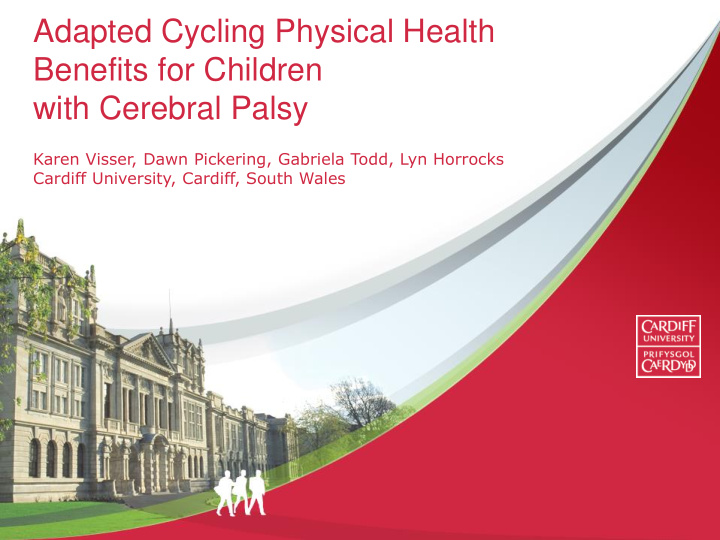



Adapted Cycling Physical Health Benefits for Children with Cerebral Palsy Karen Visser, Dawn Pickering, Gabriela Todd, Lyn Horrocks Cardiff University, Cardiff, South Wales
Outline • Introduction and Background • Methods and Participants • Results • Conclusion • Acknowledgements • References
Pedal Power
ICF (WHO, 2001) Child with Cerebral Palsy (condition) Body Structure and Cycling as an Activity Disabled child in Function society May have the potential to Muscle weakness, Lack opportunities for maintain muscle length & muscle length Participation strengthen muscles changes Environmental Personal Factors Factors
Methods • Ethical Approval: School of Healthcare Studies Research Ethics Committee, Cardiff University • Mixed Methods: Different Subject Experimental Design • Pre- & Post- Intervention assessment • Mean of 4 bilateral quadriceps & hamstrings within session strength measures (Hand-held dynamometer) • Mean of 4 Bilateral popliteal angle measures (silicon coach)
Participants • 35 children participated • 18 control group (non cycling group) • 17 Intervention group (cycling group) • Inclusion criteria: aged 2-18, GMFCS levels I – V, Cerebral Palsy, volunteered, informed consent / assent • Exclusion criteria: ORTHOPAEDIC intervention and / or Botulinum toxin injections within the past 6 months
Participants: Cycle Assessment
Measurements Figures 1 & 2: Quadriceps Strength measured with the Hand-held Dynamometer Figure 3: Popliteal Angle measured with Silicon Coach Figure 1 Figure 2 Figure 3
Intervention
Participants: Demographics Mean Age Min Max Female Male (SD) Cycling 7.12 2 17 10 8 Group (4.69) Control 7.67 2 13 5 13 Group (3.41) GMFCS I II III IV V Cycling 4 4 2 6 1 Group Control 3 8 4 3 0 Group CP Hemiplegia Diplegia Quadriplegia Cycling Group 1 8 8 Control Group 7 4 7
Results: Popliteal Angles Right Left Right Left Groups Post- Post- Baseline Baseline Intervention Intervention Cycling 44.87° 44.21° 39.64° 42.2° Group ± 14.47 ± 9.95 ± 13.57 ± 10.32 Control 50.53° 49.57° 49.14° 46.73° Group ±9.06 ±10.64 ±12.72 ±11.83 Data: No significant difference in baseline measures between group An unpaired samples T-Test: R: p=0.233 L: p=0.067 No significant difference between groups
Results: Strength Measures Baseline Mean Strength Measures and Standard Deviations Group R Quadriceps L Quadriceps R Hamstrings L Hamstrings 39.73 N 33.41 N 33.77 N 33.69 N Cycling Group (± 22.78) (± 17.06) (± 18.44) (± 15.00) 60.56 N 59.74 N 45.16 N 48.76 N Control Group (± 30.03) (± 34.57) (± 21.07) (± 25.54) Quadriceps Strength Changes R Leg L Leg Increased by 12.14 N Increased by 15.56 N Cycling Group (± 6.50) (± 13.87) Decreased by 3.62 N Decreased by 0.41 N Control Group (± 4.73) (± 1.40) Hamstring Strength Changes R Leg L Leg Increased by 5.19 N Increased by 4.23 N Cycling Group (± 3.50) (± 5.94) Decreased by 1.03 N Decreased by 1.05 N Control Group (± 0.06) (± 3.05)
Results: Cycling Group Within cycling group strength changes • Wilcoxon ranks sign Test • Statistically significant increase in quadriceps strength • Right: p = 0.018 • Left: p = 0.021 • No significant change in hamstring strength
Results: Between Groups • Significant differences in baseline measures between groups • Comparisons made using ANCOVA (SPSS18) • No significance in Quadriceps strength between groups • Right: p = 0.08 • Left: p = 0.79
Conclusion • Adapted cycling has potential health benefits • Strength increased with cycling and decreased in the group not cycling • Strength trends deserve further investigation with larger sample sizes and longer intervention periods • Therapists, educators and policy makers should consider providing adapted cycling opportunities for children with disabilities
References • Lauer et al (2008) Lower extremity muscle activity during cycling in adolescents with and without cerebral palsy Clinical Biomechanics 23: 442 – 449 • Williams and Poutney (2007) Effects of a static bicycling programme on the functional ability of young people with cerebral palsy who are non-ambulant Developmental medicine and Child Neurology 49: 522 – 527 • Bottos et al (2001) Functional status of adults with cerebral palsy and implications for treatment of children Developmental medicine and Child Neurology 43: 516 - 528 • Colver et al (2010) Study protocol: Determinants of participation and quality of life of adolescents with cerebral palsy: a longitudinal study (SPARCLE 2) BMC Public Health 10:280 • Palisano et al (1997) Development and reliability of a system to classify gross motor function in children with cerebral palsy Developmental Medicine and Child Neurology 39: 214 - 223
Acknowledgements thank you * danke * thank you * danke * thank you * danke • Children, young People and families • Nancie Finnie Charitable Trust • Pedal Power Voluntary Organisation • SOHCS, Cardiff University • Jenx, Ltd • Fellow Researchers Karen Visser: visserks@cardiff.ac.uk
Recommend
More recommend